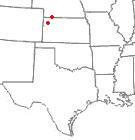
Colby, Kansas | as Puff mentioned Mizzou has done a lot of work with veris, we have done a fair amount at K-State both with the EC part and more specifically a project evaluating the accuracy and usability of data from their MSP pH rig.
The beautiful thing about Veris (or any EC data) is its correlated to everything,,, the crappy part about Veris (or any EC data) is its correlated to everything. In my experience the ability to use Veris as a proxy for some other physical property has varied from field to field and more so from region to region. I think the key thing you can do with Veris data is to identify areas that are extremes in some regard, then do some ground truthing across points the represent the range of Veris readings, then try and build a correlation to something useful.
As an example, my masters project focused on using Veris data to derive a VRT seeding prescription. In the particular fields we were working in there was an excellent correlation between Veris and soil texture, thus we could use Veris as a proxy for water holding capacity. We used this data to drive a VRT seeding prescription. Many will tell you to use veris to set up zones. I have never understood the point of that, if you have a really dense dataset such as EC data why not use it to create a surface. As you can see in the attachment that is the approach we took
In terms of a lesson on how to intrepret EC data, I think that would be really tough to do as it takes first-hand knowlege of the field to determine what the EC data is telling you, and what its telling you varies a lot by geography. In general, look at the extremes in the field and based on what you know about those areas, and through testing and groundtruthing figure out what the veris data means in that particular field. Its important to remember that one of the challenges with EC data is the scale changes, e.x. the values within a field will differ if ran on different days, thus a relationship generated from one field's worth of data is not neceissarily direclty transferable to another.
Just some thoughts
Lucas A note on the Rx below, this is on pivot irrigated ground in northeast Kansas, the driver of the variability is essentially sand so basically is ec = sand content = plant available water = optimal plant pop. This is just a potential example of what you can use EC for, not necessarily a cookbook recipe good for all readers.
Edited by LHaag 3/4/2010 02:39
 (APVRTRx.JPG) (APVRTRx.JPG)
Attachments
----------------
 APVRTRx.JPG (37KB - 46 downloads) APVRTRx.JPG (37KB - 46 downloads)
|


 Electroconductivity? Veris? what is this..
Electroconductivity? Veris? what is this..